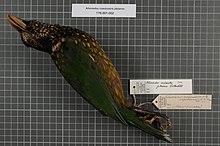| Northern catbird | |
|---|---|

| |
| Ailuroedus crassirostris jobiensis Rothschild, 1895 | |
| Scientific classification | |
| Domain: | Eukaryota |
| Kingdom: | Animalia |
| Phylum: | Chordata |
| Class: | Aves |
| Order: | Passeriformes |
| Family: | Ptilonorhynchidae |
| Genus: | Ailuroedus |
| Species: | A. jobiensis |
| Binomial name | |
| Ailuroedus jobiensis Rothschild, 1895 | |
The Northern catbird (Ailuroedus jobiensis) is a species of bowerbird (Ptilonorhynchidae) which can be found in central-northern New Guinea.
This species was formerly considered a subspecies of the spotted catbird before being reclassified as a distinct species in 2016. Martin Irestedt and colleagues examined the black-eared, spotted- and green catbird species complex genetically and found there were seven distinct lineages: the green catbird (A. crassirostris) of eastern Australia and the spotted catbird (A. maculosus) of eastern Queensland being the earliest offshoots, followed by the Huon catbird (A. astigmaticus) and black-capped catbird (A. melanocephalus) of eastern New Guinea, the Arfak catbird (A. arfakianus) of the Bird's Head (Vogelkop) Peninsula, the northern catbird (A. jobiensis) of central-northern New Guinea, and black-eared catbird (A.melanotis) of southwestern New Guinea, Aru Islands and far North Queensland.
References
- Irestedt, Martin; Batalha-Filho, Henrique; Roselaar, Cees S.; Christidis, Les; Ericson, Per G. P. (2016). "Contrasting phylogeographic signatures in two Australo-Papuan bowerbird species complexes (Aves: Ailuroedus)". Zoologica Scripta. 45 (4): 365–379. doi:10.1111/zsc.12163. S2CID 85899118.
| Ptilonorhynchidae (Bowerbirds) | |
|---|---|
| Ailuroedus |
|
| Scenopoeetes | |
| Archboldia | |
| Amblyornis | |
| Prionodura | |
| Sericulus | |
| Ptilonorhynchus | |
| Chlamydera | |
| Hybrid: Rawnsley's bowerbird (Ptilonorhynchus violaceus x Sericulus chrysocephalus) | |
| Taxon identifiers | |
|---|---|
| Ailuroedus jobiensis | |